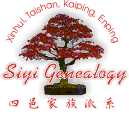

The ships, used to transport immigrants were so badly overcrowded, many slept three or four to a bunk. The small amount of food they were given was often rotting and the water fetid. it was not uncommon for a dozen or more men or boys to die during the trip,their bodies being dumped overboard like the carcass of an animal.
After a ten pound entry tax was placed on immigrants entering into the state of Victoria, many unscrupulous shipping captains would collect the tax before leaving Hong Kong, where almost all the immigrants departed from, with the promise of paying the tax on entry to Victoria, but then dump the immigrants off the South Australian coast at Robe, leaving them to their own devices to make their way to the Victorian Goldfields of Ballarat or Bendigo. In most cases this was done on foot. With so many being brought into the country in this manner, it is not surprising that few have official records of entry into the country or any form of shipping records.
Having landed in Australia they were to find they would be treated with despise and contempt by the majority of British and European migrants who felt threatened by the sheer numbers of these strangers they knew so little about. At one time In Australian History, There were more Chinese in Australia than any other Nationality. These other migrants also disliked the Chinese sending their gold back to China as they felt it was robbing the Country of its economy.
The Chinese were used to long monotonous toil and soon showed themselves to be good, hard workers, often reworking the claims the "white" miners had given up as useless. This also added to the distrust and contempt felt towards them and when marriages between the Chinese and white women, (mostly Irish as they were perceived only one class above the Chinese), frequent outbursts of violence began. One of these outbursts of violence occurred at the Lambing Flats In New South Wales. Chinese men were dragged behind horses by their ponytails, which were the customary hairstyle of the Chinese at the time. The ponytail would be cut off and taken as a trophy.
Not all Chinese were miners. Some took to their native trades as barbers or butchers, whilst others opened stores or worked market gardens. Hotels, drinking houses and gambling houses also became popular in the Chinese section of the towns and cities.
In 1901 as a result of the violence against Chinese and other perceived minority races, the "White Australia Policy" was introduced which prevented "non white" people from immigranting to Australia, excluding American Negroes. This policy remained in force untill the 1960's by which time most of the Chinese bloodline and apperance was disappearing.
By the 1960's and 1970's many people of Chinese descent had no knowledge of their family history as names were changed to prevent persecution and harrassment due to their origins.
In many Australian towns today, the only remaining signs of the thousands of Chinese that once inhabited them is to be found in the cemeteries where there lie rows of plain humble graves, the headstone carved with Chinese characters, often so badly eroded that it is difficult to read them. In modern times, the Chinese are more readily accepted as being one of the many cultures that have combined to make Australia a Multi-Cultural country and many of the old mining towns and cities have Chinese-Australian Comittees who work hard to keep this heritage alive.